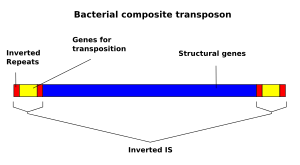Transposon facts for kids
A transposon is a special piece of DNA that can move around to different spots within a cell's genome (which is like the cell's instruction manual). People sometimes call them "jumping genes," but that's not quite right because they aren't actually genes.
The first time anyone discovered transposons was when a scientist named Barbara McClintock was studying maize (corn). She won a Nobel Prize in 1983 for her amazing work. When transposons move, they can cause big changes, called mutations, and even change the size of the cell's genome.
Contents
Types of Transposons
Transposons are one kind of "mobile genetic element," which means they are parts of DNA that can move. There are two main types of transposons, based on how they move:
Copy and Paste (Class I)
These are called Retrotransposons. They make a copy of themselves in two steps:
- First, they copy their DNA into RNA (a bit like a temporary message).
- Then, they use that RNA message to make a new DNA copy.
- This new DNA copy then gets put into a different place in the genome.
Retrotransposons act a lot like some retroviruses, such as HIV.
Cut and Paste (Class II)
These are DNA transposons. Unlike Class I, they don't use an RNA step. Instead, they simply cut themselves out of one spot in the DNA and paste themselves into another.
How Transposons Can Cause Problems
Transposons can cause mutations, which means they can damage the DNA of the cell they live in. Here's how:
- If a transposon lands inside an important gene, it can stop that gene from working properly.
- When a transposon leaves a gene, it might not be fixed correctly, leaving a gap or mistake.
- Having many copies of the same DNA sequence (like "Alu sequences" in humans) can make it hard for chromosomes to line up correctly when cells divide. This can lead to parts of chromosomes being copied too many times.
Using Transposons in Science
Transposons can sometimes carry extra genes, like those that make bacteria resistant to antibiotics. Scientists can also use transposons to put a specific gene into the DNA of an organism. For example, they've done this with fruit flies (Drosophila melanogaster) by putting the transposon into the embryo (a very early stage of development).
Examples of Transposons
- Maize (Corn): The first transposons were found in maize by Barbara McClintock in 1948. She noticed that these "jumping genes" caused changes in the plant's chromosomes. About half of all the DNA in maize is made up of transposons!
- Fruit Flies: In fruit flies (Drosophila melanogaster), there's a group of transposons called P elements. They appeared in fruit flies only in the mid-1900s but quickly spread to every group of fruit flies around the world. Scientists now use artificial P elements to add genes to fruit flies by injecting them into the embryo.
- Humans: The most common type of transposon in humans is called the Alu sequence. It's about 300 DNA building blocks long and can be found between 300,000 and a million times in the human genome.
- Mariner-like elements: These are another important type of transposon found in many living things, including humans. The Mariner transposon was first found in Drosophila. It's known for being able to move between different species. There are about 14,000 copies of Mariner in the human genome.
Where Transposons Come From
Transposons are found in many different kinds of life. They might have appeared many times on their own, or maybe they started once and then spread to other living things.
While some transposons might help their hosts, most are seen as "selfish DNA" or parasites. In this way, they are similar to viruses. Many viruses and transposons also share features in their DNA and how they work, which makes some scientists think they might have a common ancestor.
Too much transposon activity can harm a genome, which can be deadly for the cell. So, many organisms have ways to stop them. Bacteria might delete genes to get rid of transposons and viruses, while eukaryotic organisms (like plants and animals) use something called RNA interference (RNAi) to stop transposons from being too active.
In animals with backbones, almost all of the many DNA transposons in their genome are inactive. In humans, all of the Class I-like transposons are inactive. The first DNA transposon used as a tool in genetics, called the Sleeping Beauty transposon system, was actually a transposon that scientists "woke up" from a long evolutionary sleep.
Helping Our Bodies Fight Germs
Transposons might have been used by our immune system (the body's defense system) to help create many different kinds of antibodys. The V(D)J recombination system works in a way similar to transposons. This system involves three genes that rearrange themselves in special white blood cells called lymphocytes. This system helps create many different proteins to fight against things like bacteria, viruses, parasites, sick cells (like tumor cells), and even pollen.
The final DNA sequence of the antibody is very different each time, even when the same parts are joined. This huge variety allows the VDJ system to make antibodies that can fight against germs that the body or its ancestors have never seen before!
See also
 In Spanish: Transposón para niños
In Spanish: Transposón para niños


